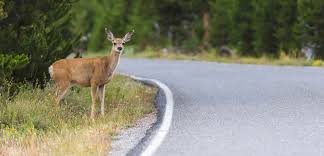NJ Drivers Beware – This is What You Need to Know About Deer Season

NJ State Police Seeks Help from the Public in Fatal Hit-and-Run Investigation
October 14, 2023
Brick’s Senior Center Unveils Grand Opening Celebration
October 14, 2023NJ Drivers Beware – This is What You Need to Know About Deer Season

Use Caution
Drivers Beware – It’s Peak Season For Deer On NJ Roads
The Toms River Police Department reminded motorists to be aware of their surroundings. As deer mating season begins and night approaches earlier, motorists are advised to drive with extra caution and keep an eye out for white-tailed deer.
During the fall rut, or mating season, white-tailed deer become more active. Deer are more likely to suddenly run onto streets when bucks follow does at this time of year, putting them at danger of colliding with a vehicle. When vision is limited, deer activity is more likely to increase in the early morning and around dusk. Keep your eyes open and stay safe!
Drivers may notice more deer along highways in the fall for two reasons:
Mating Season: Deer mating season lasts from October to late December, depending on where you live. Male deer enter the “rut” and begin actively seeking mates. As a result of this habit, deer migration increases, causing them to cross roads.
Time Changes: Our days get shorter and our nights get longer when we "fall back" for daylight savings time. Most commuters' rush hour coincides with the hours when white-tailed deer are most active—dawn and twilight.
THINGS YOU SHOULD KNOW
Deers Can Be Unpredictable:Always keep in mind that deer are wild animals and thus unpredictable. When a deer standing on the side of the road is frightened by a vehicle, it may bolt into or across the road rather than away. One Deer Usually Means More:
When a deer crosses the road in front of you, always be cautious and slow down. Because deer travel in herds, it's likely that others will join them. Beware of Time of Day
Because deer are most active at dawn and twilight, they are most commonly observed near highways early in the morning and late in the evening, when most people are travelling to and from work. Time of Year
While deer-car crashes can happen at any time of year, the breeding season in the fall is the most common. Deer movement rises during the fall breeding season, and this frequently brings them into touch with roadways that run across their natural habitats. Both at exceptionally dry times of the year and after a long, harsh winter, road shoulders typically yield useful food plants. In the late winter, early spring, and late summer, deer are drawn to these plants. During these times, drivers should be extremely cautious of deer. Minimize Damage
If it's too late to avoid a collision, drivers should slow down as much as possible to reduce damage—resist the desire to swerve to avoid the deer, since this could cause more damage, send vehicles off the road, or cause a collision with another vehicle.

